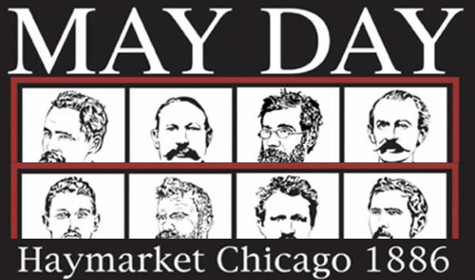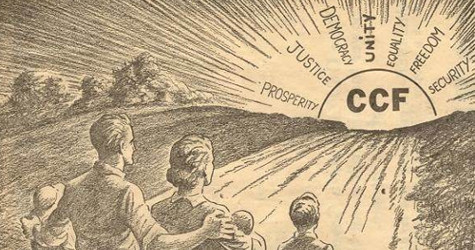Labour Day Weekend is upon us, and many union activists and their families will be out marching and picnicking, joining with brothers and sisters from other unions in a show of solidarity. While their participation is heartfelt there is no doubt many of them are asking what is there to celebrate? There are a few recent victories but not enough to prevent workers from concluding that the current Labour movement is in crisis.
 Labour Day is recognized by most unions in Canada and the U.S. as a day to promote labour’s role in the community. In 1894, it became a national holiday in Canada. The Canadian government was seeking to accommodate the Labour Movement after the rise of the Knights of Labor and the strengthening of unions in the 1880s. Shortly after, the American government followed suit, wanting in particular to offer a counterpoint to May Day, which commemorated the state violence against the 1886 Haymarket demonstrators. The contrast remains between the North American Labour Day holiday and May Day, which is Labour’s day elsewhere. While May Day stands for the international struggle against capitalism, Labour Day signifies the accommodation of workers within the capitalist system. Canada and the U.S. are the only countries where Labour Day rather than May Day celebrates the achievements of workers.
Labour Day is recognized by most unions in Canada and the U.S. as a day to promote labour’s role in the community. In 1894, it became a national holiday in Canada. The Canadian government was seeking to accommodate the Labour Movement after the rise of the Knights of Labor and the strengthening of unions in the 1880s. Shortly after, the American government followed suit, wanting in particular to offer a counterpoint to May Day, which commemorated the state violence against the 1886 Haymarket demonstrators. The contrast remains between the North American Labour Day holiday and May Day, which is Labour’s day elsewhere. While May Day stands for the international struggle against capitalism, Labour Day signifies the accommodation of workers within the capitalist system. Canada and the U.S. are the only countries where Labour Day rather than May Day celebrates the achievements of workers.
Postwar Legal Recognition
With the postwar settlement in Canada and the legal recognition of workers’ rights to organize, bargain and strike, accommodation of labour within the system was realized. By linking union certification and recognition of state-defined bargaining units in specific workplaces, the collective bargaining regime channeled unions away from broadly-based struggles and toward a narrow form of unionism centred on negotiating the price and use of labour-power at the level of the workplace. Workplace disputes were required to be resolved through formal grievance procedures rather than collective action helping to lead to the legalization of conflicts. Collective bargaining was confined to the economic issues of the workplace and separated from decisions made in the political realm. This process was powerfully reinforced by the cold war hysteria of the 1950s (and after) that resulted in the shunning and expulsion of both communists and socialists from U.S. and Canadian trade unions.
While this regime did allow for the growth of unions and material benefits for a few decades, it was already evident by the 1980s that it had reached a state of crisis. Stark evidence of this can be seen in the USA. In 2013, the percentage of workers belonging to a union was 11.3%, compared to 20.1% in 1983. The rate for the private sector was 6.7%, and for the public sector, 35.3%. In Canada (according to Statistics Canada), the rate of unionization has fallen from 37.6% in 1981 to 28.8% in 2014. There have been no significant organizing advances. Meanwhile the continual spread of precarious forms of work, such as part-time, casual, zero-hours, and contingent labour, makes organizing in the service and other new industries such as call centres extremely difficult.
There is a real danger that the Canadian labour movement, as it now stands, will go down the same road as its U.S. counterpart. The decline of union density in the private sector has reached a critical point, and the neoliberal turn to austerity has reduced the effectiveness of unions to make gains. At best, unions are fighting against rollbacks. But in many instances, the acceptance of concessionary collective agreements continues – particularly with respect to defined benefit pension benefits. Public sector union benefits are constantly under attack with insidious comparisons made to non-union private sector companies. The recent embrace of social movement unionism by many unions as the way forward has done little to boost the capacities of labour. While this has led to greater involvement of unions nationally and locally with other social movements, it has not entailed the significant changes in union structures, practices and priorities that might have prevented the crisis of the current model of trade unionism from deepening.
Signs of Revival
If overall unions, in both the U.S. and Canada, have been slow in recognizing the need for major changes, recently there have been some encouraging developments. The ‘Fight for $15’ in the U.S. stands out as a movement that has bypassed the union certification process
and has developed a community-based strategy in support of workplace-based actions to redress grievances. Starting with a few hundred fast food workers right across New York City in 2012, who went on strike for $15 an hour and union rights, the movement has grown considerably in a short period of time. In April 2015, tens of thousands of striking fast food workers in more than 200 cities were joined by other low paid workers, including childcare and homecare assistants, Walmart workers and airport staff, many of whom were women and racialized workers. The Service Employees International Union (SEIU) now supports this community-based movement and is helping to organize the strikes and demonstrations. In November 2015, Bernie Sanders spoke out in support of the movement pushing Hillary Clinton to support $15 as a minimum wage standard.
Another widely noted example concerns the determined efforts of the Chicago Teachers Union (CTU) to break out of the confines of a narrow
collective bargaining system through an ongoing fight for real systemic change within the education system. In September 2012, they went on strike against school privatization and the broader “corporate reform agenda.” But they realized that they couldn’t depend on collective bargaining alone to fix the failures of the public school system. They are continuing to build the capacity of education workers, parents, and the community as a whole in a broad alliance in the working class areas of Chicago to challenge the racist inequality of the system.
Turning to Canada, the Leap Manifesto: A Call for a Canada Based on Caring for the Earth and One Another offers another example of ambitious, imaginative thinking. The Manifesto proposes a restructuring of the economy away from fossil fuels and has forged alliances with unions and community groups in the hope of moving the project forward. The Leap‘s support of the One Million Climate Jobs project has brought the Canadian Labour Congress (CLC) and Indigenous and environmental organizations together to work together on a climate job creation plan. While Leap doesn’t explicitly address the problems of capitalism (and its social relations of production), it does call on the labour movement to go beyond its traditional focus on the price of labour and its use and instead concern itself with the character of production and public control of investment.
The CUPW Example
Then there is the Canadian Union of Postal Workers (CUPW) with its ambitious vision for the Post Office of the future. CUPW has often been noted as a union prepared to break new ground. This has included founding the Winnipeg Workers Action Centre to support unorganized and vulnerable low-income workers. More famously, CUPW organized rural and suburban mail contractors for several years despite a legal prohibition against forming a union, and ultimately pressured Canada Post into voluntarily agreeing to the creation of the certified RSMC (Rural and Suburban Mail Carriers) bargaining unit in 2003.
The recent developments arose out of the union’s efforts to respond to four hard years of concessions-infused bludgeoning at the hands of the Harper government and the market fundamentalist leadership of Canada Post Corporation. These included the decision by Canada Post to completely eliminate door-to-door delivery and 8000 good union jobs in late 2013. If the union couldn’t find a response, it could have faced a future of growing irrelevancy, so its activists chose to fight. The first step was to develop a campaign around postal banking. This not only served to answer the argument that the Post Office was a more or less hapless victim of the digital crisis; the banking initiative also opened up the prospect of a host of real benefits for some of the most vulnerable in our society.
In order to advance this campaign, CUPW nourished a growing relationship with the Canadian Postmasters and Assistants Association (CPAA, a
much smaller rural union) and ACORN, the well-known national organization of low-income community activists which has long fought against predatory lenders and the policies of the big banks (ACORN now embraces CUPW’s project of postal banking). At the same time,
CUPW developed a strategy of community based initiatives to Save Canada Post, featuring door-to-door campaigning, aggressive demonstrations and sit-ins, a call for a postal mandate review under a new government, and then began working with the new organization, Friends of Public Services, to expand its outreach.
It soon became clear that the upcoming negotiations for a new collective agreement were inextricably connected to the development of a forward-looking proposal about the future role of Canada Post as a public service. With the election of the Justin Trudeau Liberals and the promise of a postal review, this objective developed into an alliance including ACORN, CPAA, Friends of Public Services and the Leap Manifesto group. This alliance developed the widely distributed program Developing Community Power. While still a work in progress, it envisions Canada Post as a green hub providing community economic development and social care along with postal banking – imaginative new possibilities for the role of public services in what is now often called the “new economy.”
The first fruits of these initiatives were reflected in the negotiations for a new collective agreement with Canada Post that was just concluded. CUPW succeeded in forcing the post office to abandon all of its key demands for concessions including a ‘defined contribution pension plan’ for new hires, the right to close up to 500 retail outlets, and changes to work rules. The union also won a modest wage increase and a commitment to address its main demand of pay equity for its rural members within 19 months following an expedited review by a Pay Equity Committee. This last achievement was greatly assisted by CUPW’s outreach to women across the country, including the release of a powerful open letter to the Prime Minister signed by 200 well-known women insisting that he live up to his pay equity commitments.
The Struggle Continues
CUPW’s victory at the bargaining table means that the union is in a much better position to promote the vision of Community Power that it developed with its allies. The Canada Post Review process, which was a Liberal election promise, is well underway and has the potential to give the proposal high visibility. Community groups have started to hold meetings around the proposed vision and support from activists around the People4Posties national network and the Developing Community Power group is ongoing. Support from the CLC, other union centrals, and individual unions is crucial to the process. But the solidarity initiatives need to go further and an awareness needs to be built that all unions are implicated and have a stake in the fight for the expansion of public services.
This is precisely because the next phase of the struggle is not going to be easy. Both Leap and Delivering Community Power have laid out remarkable visions of how we could transform our communities. At the same time, neither in and of themselves is particularly radical. There are large postal banks in many major capitalist countries including France, England and Japan. As for Leap, as Avi Lewis himself noted when speaking in Ottawa, the only really radical thing about the Leap manifesto is its implicit suggestion to leave the oil sands in the ground.
The radicalism of both proposals lies in the need to confront and challenge capital if the visions are to be achieved. The banks and the pay day loans they support will fight tooth and nail against postal banking. The petroleum companies will strenuously oppose any suggestion that they give up billions in profit by leaving the oil unexploited. Moreover, leaving the oil in the ground poses a serious threat to thousands of jobs and indeed to Fort McMurray as a whole, and will meet with serious resistance from some parts of labour. This will not be overcome by promises of new retraining programs. Restructuring the oil industry will require serious planning, including financial planning, and this won’t be possible without challenging capital. This also won’t be possible without a much more powerful, politicized movement of community and labour organizations than exists now. It will need to be a transformed movement which sees itself as an integral part of working class communities in cities and towns across the country.
This Labour Day there are hopeful signs that this transformation is beginning. The strategy of community-based initiatives that CUPW developed to save Canada Post from further cuts and privatization was a crucial part of the union’s strategy going into this round of negotiations. Victory at the bargaining table could not have been achieved without them. Other struggles, such as that of the Chicago teachers and the North American-wide Fight for $15 campaigns for low-paid workers have raised the possibility of breaking out of the straight jacket of the current labour relations regime. These struggles not only open the way to new possibilities for labour’s collaboration with other popular-based groups and organizations; they also raise the political aspirations for the entire labour movement and for the Left as a whole. •





